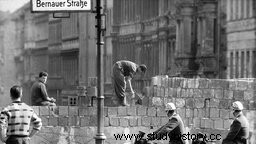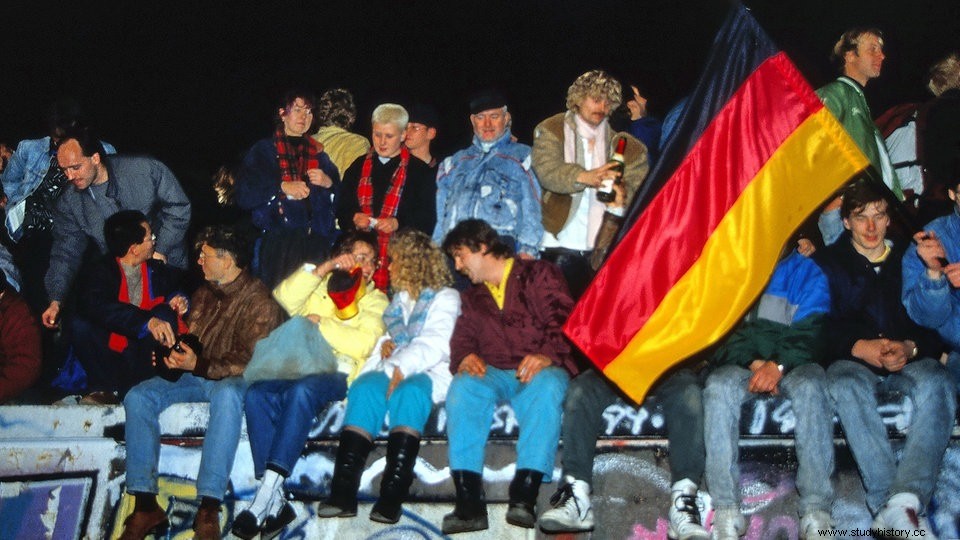The Berlin Wall went down in history as a symbol of the Cold War and the division of Germany. It was built in 1961 to stop the flow of refugees from east to west.
German-German border
Since 1952, the leadership of the German Democratic Republic (GDR) had cordoned off its territory to the west. The inner-German border had an exclusion zone several kilometers wide and stretched almost 1400 kilometers from Bavaria to the Baltic Sea. It divided settlements and landscapes, cut up roads and railway lines, and shaped the lives of millions of people.
Only six railway crossings and five road or motorway crossings were still open for traffic between the Federal Republic and the GDR and Berlin. 200 streets were closed in and around Berlin, and telephone connections to the western part of the city were cut.
Many residents were forcibly resettled from the immediate vicinity of the inner-German border. Berlin became a refuge for refugees. With the building of the wall it was stopped.
13. August 1961:The construction of the Wall begins
As late as June 1961, Walter Ulbricht publicly declared:"No one intends to build a wall!" The head of the Socialist Unity Party (SED) had long considered sealing off East Berlin from the west of the city. However, approval from Moscow did not come until the beginning of August.
During the night of August 12-13, the People's Police, company combat groups and the National People's Army (NVA) blocked the sector border running through Berlin with barbed wire and stone walls.
In the days and months that followed, a 46-kilometer wall was erected between East and West Berlin, and finally fortified border installations around West Berlin over a distance of a good 155 kilometers. The population could no longer move from one part of the city to the other.
Hesitation in the West, rejoicing in the East
The Berliners were stunned; international reactions tended to be muted. The western powers hardly protested, their free access to West Berlin was not endangered.
General Lucius D. Clay, the US special envoy to the city, brought in tanks a few weeks later, in October 1961. He wanted to know whether it was only dealing with the Ulbricht regime or with Moscow. When Soviet tanks rolled up on the other side, it was clear.
The political leadership of the GDR celebrated the construction of the wall - in the language of the SED propaganda "anti-fascist protective wall" - as a "victory of the socialist camp over western imperialism". Essentially, the GDR leadership was concerned with stopping the flow of refugees, because up until the Wall was built, the GDR had lost hundreds of thousands of its citizens to the West every year.

The Wall changed the image of Berlin for decades
Escape attempts and kill shots
The concrete walls, ditches, treadmills for trained watchdogs, watchtowers and rifle positions made the state border almost impassable. At least 235 people died trying to get to the west. Nevertheless, many tried their luck, often with spectacular escapes from the wall.
-
 How the Berlin Wall continued to expand over the decades | more
How the Berlin Wall continued to expand over the decades | more
9. November 1989:opening of the wall
The hoped-for political and economic stability, which the GDR leadership wanted to achieve by sealing off the borders, among other things, actually led to an increase in living standards. However, "actually existing socialism", as the SED leadership called their social order, ultimately proved unsustainable. At the end of the 1980s, the system in the GDR collapsed.
Mikhail Gorbachev had come to power in Moscow and was trying to modernize the state and government apparatus. He reformed the Soviet Union under the keywords "glasnost" (in English "openness", "transparency") and "perestroika" (in English "conversion", "restructuring"). This also had an impact on the other socialist states in Central and Eastern Europe.
The GDR leadership lost the support of the Soviet Union. In all big cities people protested for their freedom. A wave of refugees via Hungary and Czechoslovakia exacerbated the situation.

The wall has fallen
On October 18, 1989, the SED Central Committee deposed the Chairman of the State Council, Erich Honecker. Nevertheless, the opening of the border on the evening of November 9, 1989 came as a surprise to everyone. The wall fell. The turning point could no longer be stopped. That evening, thousands stormed the border crossings and celebrated the "Miracle of Berlin".
Today, the traces of the Wall have largely disappeared from the landscape and the Berlin cityscape. In Berlin itself, only 1.5 kilometers of remains of the Wall can be found, the rest was sold all over the world. Paving stones at the Brandenburg Gate are reminiscent of the former course of the Wall.
